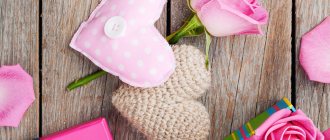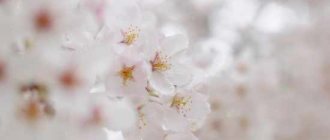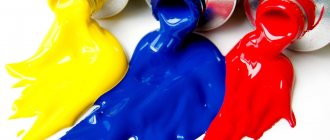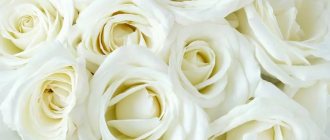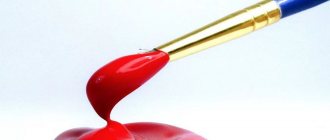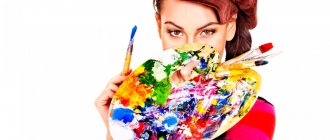The influence of colors on the mental state of people has been studied since ancient times. Each of them means something. When looking at a certain color shade, a person experiences certain feelings that affect the rise or fall of mood. Often people are inclined to choose a certain option without even thinking about the fact that this decision was influenced by color.
Why certain colors are used in different fields of activity, and how to apply color characteristics for your own purposes is described below. We're talking about the color brown.
Positive meaning of brown in various cultures
For the ancient Greeks, brown color was closely associated with the image of the goddess of the life cycle and fertility Hera and was considered one of the most honorable and used in everyday life. Rich chocolate shades of the brown spectrum were revered by both the ancient Egyptians and the aborigines of the African continent, and in each case the color of the earth was considered a symbol of home, stability and strong family relationships.
In Slavic life, brown color was rarely found, and then mainly in the form of the natural color of various labor materials, which corresponded to its symbolic meaning - mother earth. The Russian ancestors of the simple class avoided wearing clothes of dark, brown shades - it was believed that only the animal that was the totem of the Slavs - the bear - was allowed to have this color, as well as the powerful of this world - princes and eminent citizens. Everything that was compared with the cult image of the forest owner: strength, perseverance, indestructible ferocity - was automatically associated by our ancestors with the color brown.
Negative meanings of brown
Most modern people have a cool attitude towards the color brown, and there are many reasons for this, given the influence on the minds of various religious and historical facts associated with coffee and chocolate shades. Thus, since ancient times, Islamists have been of the opinion that dark, earthy tones are symbols of social and moral decay, devastation, and ignorance. Representatives of the Catholic Church of the Middle Ages believed approximately the same thing - this color, in their presentation, personified the poverty of life and spirit, moral decline, incest and lust.
Christianity interpreted wearing dark brown clothes as a sign of worshiping the devil and serving dark forces, but the peak of negative attitudes towards this color occurred in the 20s of the last century. This period was marked by the popularization of the fascist movement in Germany, which, thanks to the brown form of aggressive youth, remained in history under the name “brown plague.”
Business
If you are still looking for yourself and a job, try wearing a brown suit, or at least a watch and shoes, to an interview. This will have a positive impact on your image and will inspire confidence as a professional and competent employee. It will also give the impression that you are hardworking and confident.
Ideal for government agencies, or those involved in protecting citizens and associated with justice and power. For example, this could be a court or a law office, a notary. To indicate quality, reliability and emphasize status, they are used to advertise clothes, cars, watches and other accessories.
Try to avoid it if you work in the healthcare industry. Given the nuance that brown, like green, is perceived as natural colors, it can cause associations that will negatively affect your business.
Brown color in psychology
Despite its conservative and respectable appearance, brown is rarely on anyone's list of preferences for long enough. Even more rarely, it accompanies a person throughout his life. What does brown mean in psychology? Experts note that the desire to surround oneself with brown and coffee shades is observed in a person with the following changes in mental state:
- with depressive disorder and loss of self-confidence;
- if necessary, get rid of difficult thoughts or get out of a protracted conflict situation;
- for chronic fatigue, mental “burnout”.
Teenagers often choose this color, trying to get away from the sensuality awakening in them and to drown out their protest against their usual way of life. An even, natural color gives a feeling of stability and serves as a guarantee that everything will work out well and as it should.
People who do not get enough sleep, are exhausted from work or are often exposed to stress, instinctively strive to bring a lot of brown details in soft tones into their wardrobe or home interior. The abundance of such elements gives a feeling of physical liberation, peace, and harmony.
Rejection, a categorical dislike for the color brown, is characterized in psychology as a desire to rise above the primitive needs of the body. Bright individualists, spiritual personalities, and creative people do not accept dark shades - from coffee to clay.
What properties does it have?
Brown color has a calming property and has a rather positive effect on a person’s condition. Does not cause aggression or anger.
A person who finds himself in a room with brown tones can relax and unwind. They say that brown will even help resolve conflicts and come to a common opinion. Brown is the color of relaxation and even a little laziness.
This color also has the ability to inspire confidence in people. Seeing a person in brown clothes, we consider him confident, responsible and reliable.
But in excess, brown can also have negative properties . If a person has depression, it can make it worse and can also cause obsessions and increase paranoia.
Zodiac preferences
Since in psychology the value of brown color is emphasized as a factor of “grounding”, a return to nature and natural simplicity, this color is ideal for two zodiac signs - Virgo and Capricorn.
The practical Capricorn always strives to remain unconvinced, but he hates to complicate everything and, in search of the truth, inevitably returns to the basics. Capricorn has a vital need to periodically turn to the experience of his ancestors, and the brown color helps him not to lose this connection and remain something of a keeper of family traditions and ancestral memory.
Thoughtful and pedantic, Virgo never has her head in the clouds, and in all matters prefers to use the shortest path to solving a problem. Dark shades such as “brown”, “mahogany”, “chocolate” help Virgo to concentrate and not be distracted by unimportant details.
Personality characteristics
- Reliability. Such a person is reliable, stable and loyal. Why is he a good friend, colleague, partner, etc. He will remain faithful, despite any temptations and offers;
- Health. He does not like to fantasize and indulge in daydreams, preferring to notice reality as it is. This helps him to be more resilient and ready for different situations;
- Disappointment. It is precisely because such a person does not wear “rose-colored glasses” that he is disappointed in people and life in general;
- Depression. It may be a sign of onset depression, especially if you previously had a cold attitude towards this shade, and at some point it unexpectedly became a favorite. You can take this depression test.
- Honesty. Such people are open and strive to form relationships in which it is calm and good, which is why they do not like to lie and manipulate, believing that this leads to conflicts and misunderstandings. By the way, you can test your ability to manipulate.
Unacceptable for those who ignore their own needs for rest. And both physical and psychological. That is, from stress, conflicts, communication. Also individuals who decide to go in search of their individuality. During this period, they choose brighter colors, exploring them and “trying them on” for themselves.
Brown color in the Luscher table
The Luscher color test defines brown as a deep yellow-red, looking passive enough not to appear impulsive. As a rule, the test taker places a card of this color outside the periphery of the key zone, which is the absolute norm. This means that a person evaluates his physical condition as satisfactory and does not consider it necessary to concentrate on health issues.
A brown card that takes its place among the first in the row is considered an alarming sign, indicating the patient’s subconscious fear for his life, freedom and safety. People who do not have their own home, are chronically ill, or are deprived of family ties, thus declare their priority desire to get rid of the problem, and not to acquire something new. Perhaps behind the desire to isolate yourself is a heavy dependence on finances, a failed personal life, or accumulated fatigue.
Clothes in brown tones
Psychologists call the brown color in clothing both the choice of the powerful and the preference of the vulnerable. The first category of people belongs to the true connoisseurs of a practical life position - it is important for them that their clothes are always impeccable, do not get dirty, and do not serve as the subject of undue attention. This color is chosen by hidden manipulators, as well as very thrifty people who live with a constant eye on their peace of mind and sense of inner comfort.
The second category reveals emotionally depressed people who are looking for support on a physical level - financial stability, material wealth, family status. In such clothes, especially if they include 2-3 shades of brown in muted tones, it is easy to hide in the crowd after waiting out some difficult period in life.
Now a few words about the psychology of women. The color brown in a lady's wardrobe is closely associated with the bleak, baggy clothes of Soviet times, when bright fabrics were difficult to obtain and the fair sex was forced to dress almost alike. For this reason, modern women very rarely buy toiletries in chocolate and coffee shades, although dark colors can favorably emphasize the advantages of a figure and hide flaws.
Young people should not get carried away with painting their lives in chocolate tones, as such a choice can visually age a person and give the image a touch of fading. It is better to focus on beige shades, complementing the suit with bright, contrasting accessories.
Application in advertising
Brown psychology is also used by advertisers. Along with green, brown is used in advertising to emphasize the naturalness of the product being offered. For example, manufacturers package organic cosmetics in beige or brown paper. The same applies to food.
The stability of brown in advertising for banks and other financial institutions attracts new customers.
Catering establishments choose this color to develop their logo. Thus, their coziness and the quality of the cuisine are emphasized.
Companies with a long history use color to create the status of a reliable, stable and proven organization.
Interior solutions
Color psychology considers the presence of brown in the interior as a desire to enhance the energy of stability and peace in the house, to give the home a solid and at the same time discreet appearance. Floor coverings and furniture are usually made in brown, chocolate and coffee shades.
Even if a person does not welcome the dark brown color, both psychologists and bioenergeticists strongly recommend including it in the interior of the home. It is not necessary to fill the rooms with furniture arrays of an irritating shade - it is enough to use it in the decoration elements of the surrounding environment.
Feng Shui adherents assign a special position to the color brown in the house and actively use it in the eastern part of the home, which is responsible for health and family well-being. In this zone it is good to relax after a working day and gain strength before any decisive event.
Choice of stars
Luxurious shades of mahogany and golden brown are perfect for dresses for the most special occasions. Therefore, they are often chosen by famous personalities. For example, actress Tracee Ellis Ross chose a golden-brown velvet dress for the 2016 Oscars.
The effect of brown color on physical condition
If a person periodically likes the color brown, psychologists advise him to pay attention to his health, since such unexpected sympathy may indicate an unconscious desire to get rid of the problem on the physical level.
Because all brown shades contain warm, stimulating notes of orange and red, this color will be useful for:
- circulatory disorders;
- weak immunity;
- chronic fatigue;
- interruptions in heart rhythm.
At the same time, color therapy with the inclusion of coffee and chocolate notes of the brown spectrum helps reduce the activity of brain processes, regulates blood pressure, and normalizes sleep.
Physiological effects
Brown color has a complex structure, therefore it combines both positive and negative properties. Cold and warm energy manifests itself depending on the purity and saturation of the shade. Brown-red and orange shades have a warming effect. It stimulates blood circulation and improves immunity. Psychologists and physiologists recommend wearing items or clothing of these shades to increase strength and replenish energy.
Light brown improves memory and helps concentrate. It is recommended for use by people associated with mental activity. It is believed that a brown stone or candle will help you pass an exam or test.
Rich and deep shades of brown have a calming effect. These colors help extinguish strong emotions, relieve stress and anxiety. At the physiological level, dark brown helps slow down metabolism and stimulate the nervous system. Any item of this color can slightly lower blood pressure and soften anger.
Impact on the psyche
Psychologists call the color brown “prepossessing” and “inspiring trust.” When going through difficult life stages, people tend to return to their origins, to be closer to nature - that is, to turn to what accompanied humanity throughout the entire path of its formation. By calling on the color of the earth or tree bark for help, a person begins to see the situation from the perspective of the shortest path to realizing his goal.
Sometimes, in order to solve an important problem, you need to temporarily abstract yourself from society, concentrate on your feelings and identify goals. In this case, the person will unconsciously strive to become invisible, to close himself with a shell that no one will have the desire to look under. The ideal choice for blending in with the crowd would be neutral shades of brown - taupe, clay, olive.
What does brown aversion mean?
Brown, like black, leads in negative attitudes towards them.
For some, it does not evoke the best associations, while others simply do not like it because they consider it boring and banal.
Most often, people who are too impulsive , those who live “one day at a time”, and those who do not think for a long time when making any decision do not like him. For them it is boring, it lacks colors and brightness.
He is also not liked by those who constantly want to stand out from the gray crowd, who do not like routine and sameness. Often these are creative people who find it difficult to sit in one place.
Brown is also viewed negatively by those who are trying to establish themselves in life, to show that they are individual and different in some way from others.
Brown lovers - who are they?
Psychologists divide those who love the color brown into two conditional categories: “those in need of protection” and “self-sufficient.” For the former, sympathy for the chocolate and coffee environment flares up suddenly or intensifies in waves, and then, with the loss of need, fades away. These people, as a rule, are defenseless in the face of difficult life circumstances and are in dire need of stability and constancy.
“Self-sufficient” include conservatives who consciously perceive life as endless resistance to opposing forces. The characteristics of people whose favorite color is brown are as follows in psychology:
- low creative quotient;
- high efficiency;
- pragmatism and prudence;
- lack of daydreaming and adventurism;
- consistency and logic.
Fans of dark coffee tones are not artistic or sociable, but they are wonderful friends and excellent leaders. The only clear fear of these people is the need for spontaneous actions, which they will try to avoid with all their might.
Health
It calms and helps you relax. Therefore, those for whom it is important to take care of their nervous system and restore it are recommended to be more often among brown-colored things and interior items. It is especially useful if the room is made of wooden materials. Then, in addition to color, the smell will also contribute to relaxation and oblivion.
Helps increase self-esteem and believe in yourself. Become more stable and resilient. It is suitable for people who need a feeling of security. For example, after experiencing violence, a person constantly experiences anxiety, because he does not know what else to expect. She seems to be in a state of readiness to resist and defend herself. And this is very tiring and wastes the body’s resources, leading to neuroses and phobias.
But its excess interferes with concentration and makes it incapacitating. And it may well provoke the emergence of a melancholic mood, which, along with life’s troubles, may well cause depression.
Color manipulation
If a person reading this article caught himself thinking that it’s time to put things in order in his life, then it’s better to start by adjusting the color scheme of the surrounding space and wardrobe. Surprisingly, even 1-2 accessories in clothing and a couple of additional details in the decoration of the room, made in a rich chocolate or pleasant cinnamon color, can bring harmony to the mind of the owner and make him more collected.
When applying for a job in an important government position or in an office where compliance with a dress code is required, psychologists recommend wearing a brown jacket or good dark shoes of a rich coffee color. This will serve as a signal to the employer that he is a responsible and balanced person. But for workers in the food industry or doctors, the color brown in everyday wear is contraindicated - it will cause unpleasant associations and can serve as a reason for dissatisfaction among others.
Interior
Creates home comfort, an environment where you want to relax, unwind, reflect on life, and finally take a nap. It will be appropriate in absolutely any room. It helps to expand the space, and light shades create an atmosphere of trust. It is easier to make decisions in such a room. It seems that everything will work out in any case, and you have enough strength to cope with any problem. Dark shades are suitable when you want to emphasize well-being and success. That is, to emphasize prestige and social status.
Add it to the nursery to slightly balance the irrepressible energy of an active and active child. But always in combination with other bright colors. Otherwise, the baby will be bored and not interested in being in his room. In the kitchen, it will help you enjoy food, eliminating overeating or loss of appetite. In the bedroom it will promote quality sleep; in the morning you will feel cheerfulness and lightness in your body.
